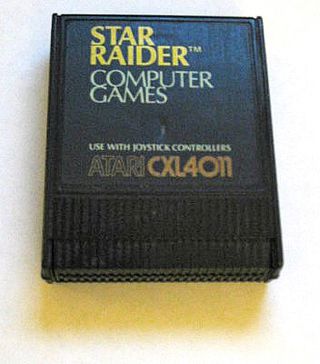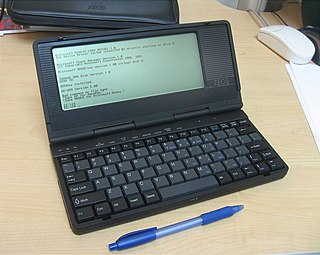
The Sinclair ZX80 is a home computer launched on 29 January 1980 by Science of Cambridge Ltd.. It is notable for being one of the first computers available in the United Kingdom for less than a hundred pounds. It was available in kit form for £79.95, where purchasers had to assemble and solder it together, and as a ready-built version at £99.95.

The Pivot is a family of early IBM PC–compatible portable computers first released in 1984 by Morrow Designs, a company founded by George Morrow. It was the first lunchbox-style portable computer, with a vertically configured case that has a fold-down keyboard. The only external component is a single AC adapter. It would have been a little top heavy except for the large camcorder-style battery loaded into its base. The Pivot was designed by Chikok Shing of Vadem Inc.

The LTE is a line of notebook-sized laptops manufactured by Compaq Computer Corporation, introduced in 1989 and discontinued in 1997. It was the first notebook computer sold by Compaq and the first commercially successful notebook that was compatible with the IBM PC.
Ohio Scientific, Inc., was a privately owned American computer company based in Ohio that built and marketed computer systems, expansions, and software from 1975 to 1986. Their best-known products were the Challenger series of microcomputers and Superboard single-board computers. The company was the first to market microcomputers with hard disk drives in 1977.

A ROM cartridge, usually referred to in context simply as a cartridge, cart, cassette, or card, is a replaceable part designed to be connected to a consumer electronics device such as a home computer, video game console or, to a lesser extent, electronic musical instruments.
The MBC-550 series, also known as the MBC-550/555, is a series of personal computers sold by Sanyo. It was unveiled at the COMDEX/Spring '83 in April 1983 and first released to market in March 1984. All models in the MBC-550 series featured pizza-box-style cases and Intel 8088 microprocessors and run versions of MS-DOS. On its release in 1984, the MBC-550 was the least expensive IBM PC compatible released to date, at a price of US$995. The MBC-550 series followed Sanyo's MBC-1000 line of CP/M computers.

The BBC Microcomputer System, or BBC Micro, is a series of microcomputers designed and built by Acorn Computers Limited in the 1980s for the Computer Literacy Project of the BBC. The machine was the focus of a number of educational BBC TV programmes on computer literacy, starting with The Computer Programme in 1982, followed by Making the Most of the Micro, Computers in Control in 1983, and finally Micro Live in 1985.

The IBM Personal Computer XT is the second computer in the IBM Personal Computer line, released on March 8, 1983. Except for the addition of a built-in hard drive and extra expansion slots, it is very similar to the original IBM PC model 5150 from 1981.

The Zeos Pocket PC is a palmtop PC marketed by Zeos International beginning in 1992. The palmtop features an NEC V30 clocked at 7.15 MHz, came shipped with MS-DOS 5.0 in ROM, and has a monochrome LCD capable of displaying graphics at maximum resolution of 640×200 (CGA). These features make the Pocket PC compatible with most IBM PC software out at the time of its release. The Pocket PC is a badge-engineered version of the Tidalwave PS-1000, manufactured by Tidalwave Microtech of Taiwan. It sought to compete with the Poqet PC, another PC-compatible palmtop computer.

The PCradio was a notebook computer released by International Business Machines (IBM) in late 1991. Designed primarily for mobile workers such as service technicians, salespersons and public safety workers, the PCradio featured a ruggedized build with no internal hard disk drive and was optioned with either a cellular or ARDIS RF modem, in addition to a standard landline modem.

The ActionNote was a series of notebook-sized laptops developed by Epson America in 1993. The series was Epson's answer to the small businesses and home office market for laptops and initially ran alongside their corporate-oriented NB series of laptops. The series was segmented into premium and low-cost offerings and included a subnotebook, the ActionNote 4000. The bulk of the laptops' manufacturing was performed by ASE Technologies of Taiwan, with the exception of the 650 and 660 series, which were produced by Compal, and the short-lived initial entries into the 700 series, which were produced by Jabil Circuit. The ActionNote received mixed, mostly positive, reception in its lifespan before Epson America silently left the personal computer market in 1996.
Pacific Cyber/Metrix, Inc. was an American computer company based in California. The company was founded in 1975 in San Ramon, California.

The RoadRunner was an early laptop designed by MicroOffice Systems Technology and introduced in 1983. Weighing roughly 5 pounds (2.3 kg) and featuring a battery able to power it for up to eight hours, the RoadRunner was one of the first clamshell notebook computers ever released.

The Executive Partner is an IBM PC-compatible portable computer that was introduced by the Panasonic Corporation in 1985. The portable computer is AC-powered exclusively, weighs between 28 and 30 pounds (14 kg), and features a built-in printer. The Executive Partner was one of the first affordable portable computers with a plasma display.

Martin Research Ltd., later Qwint Systems, Inc., was an American computer company founded by Donald Paul Martin in Northbrook, Illinois, United States. The company released their Mike family of modular kit microcomputers starting in 1975. These computers, spanning several models based on the Intel 8008, 8080, and Zilog Z80 microprocessors, proved very popular among hobbyists who wanted an inexpensive trainer computer.
Gnat Computers, Inc. was an American computer company based in San Diego, California, founded in 1976. The company was an early developer of microcomputers and one of the first—if not the first—to license the CP/M operating system from Digital Research. They released various computer hardware, including two microcomputer systems, before they were acquired by business partner Data Technology Industries, Inc., in 1983.

Informer Computer Terminals, Inc., originally Informer, Inc., and later Informer Computer Systems, Inc., was a privately held American computer company active from 1971 to 2007. It manufactured data terminals that could communicate with mainframes and minicomputers, mainly those manufactured by IBM and Digital. It was originally based in Los Angeles, California; in the early 1980s, it moved to Laguna Beach, and in the late 1980s, to Garden Grove.

The Baby! 1 is a transportable microcomputer released by STM Systems Inc. of Mont Vernon, New Hampshire, in late 1976. The computer was based on the MOS Technology 6502 microprocessor and came in a small enclosure that fit inside an attaché briefcase that came shipped with the computer. Byte magazine in 1985 called it the first portable microcomputer, although it more closely resembled the home computers of the 1980s such as the Commodore 64 than early laptops like the Grid Compass.














